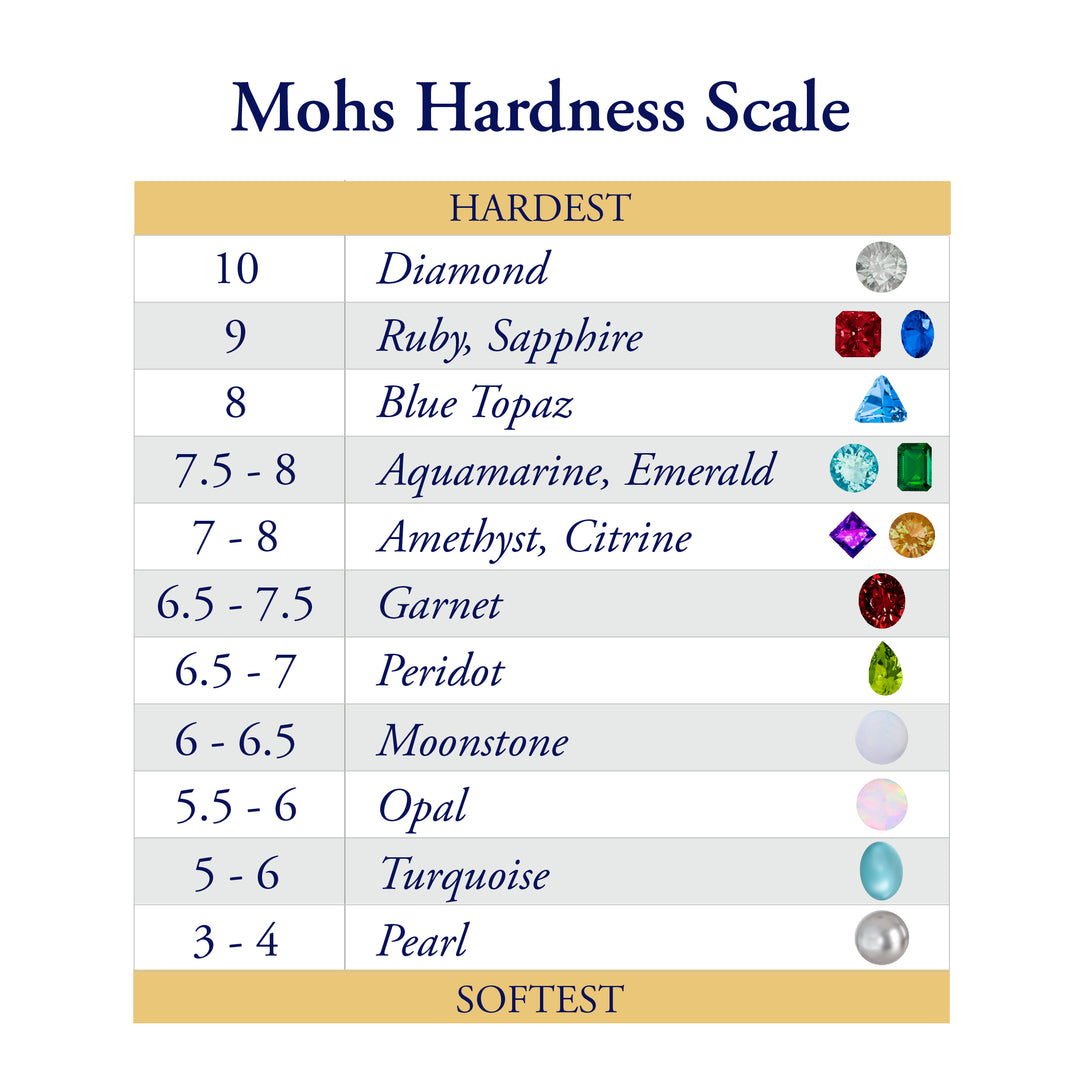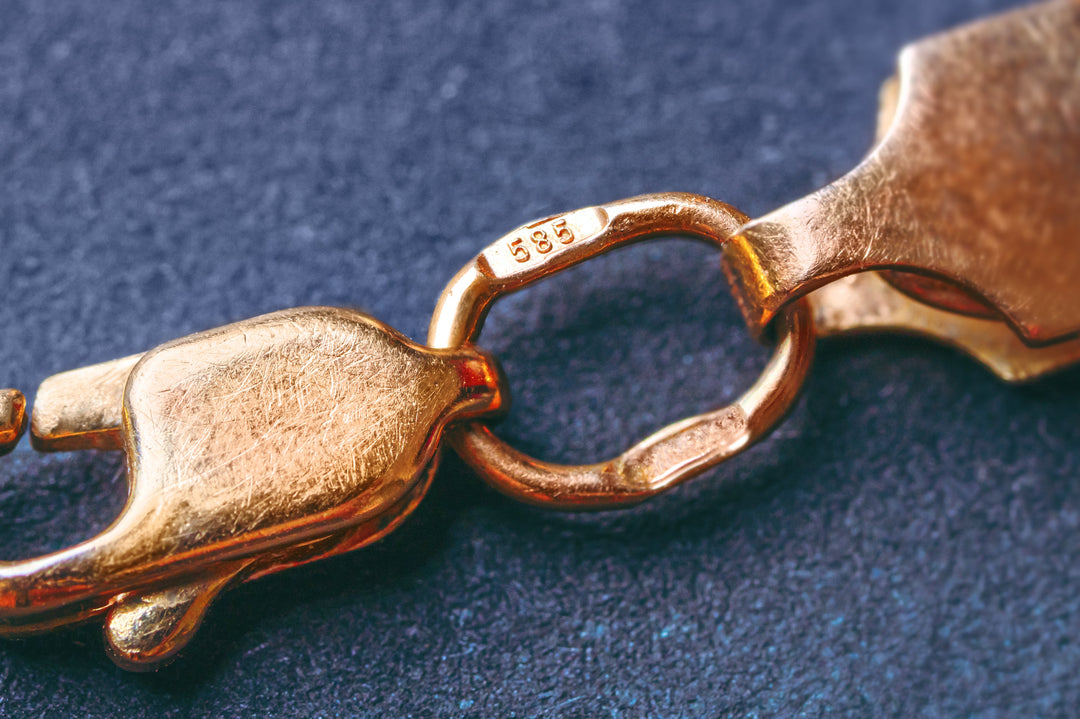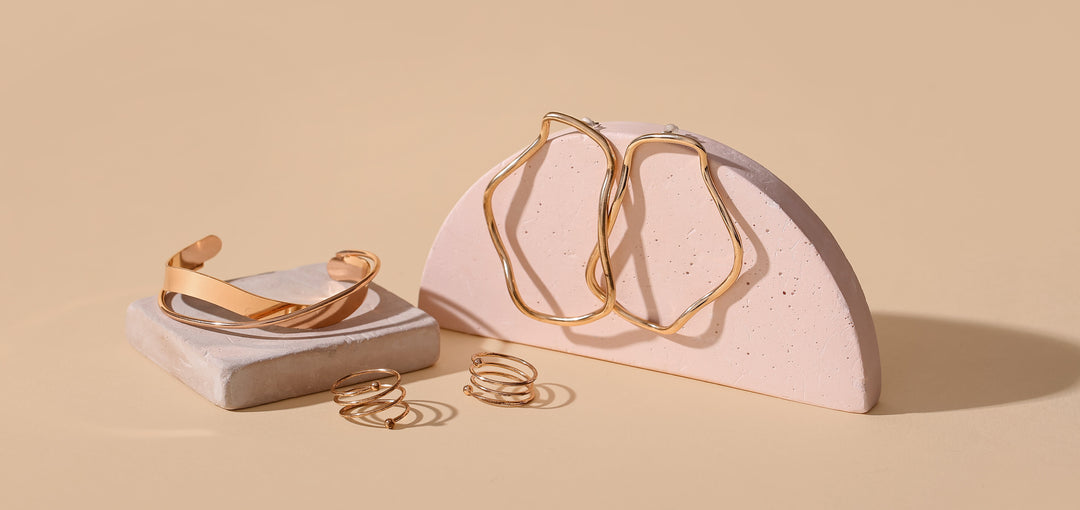The Importance of Caring for Gemstone Jewelry
Gemstone jewelry is more than just an accessory; it holds deep emotional significance and timeless beauty. From the engagement ring passed down through generations to the statement necklace that completes your favorite outfit, these pieces deserve proper care to maintain their brilliance, color, and structural integrity. This guide will provide expert tips on how to care for and clean your gemstone jewelry, ensuring it stays beautiful for years to come.
The Moh's Hardness Scale
The Mohs hardness scale measures a gemstone's resistance to scratching, ranging from 1 (softest) to 10 (hardest). This scale is vital for understanding how to handle and store your gemstone jewelry. Harder gemstones, such as diamonds, rubies, and sapphires, are more durable but can still chip under sharp impacts. Softer stones, such as pearls, turquoise, and opals, require extra care to avoid scratches and damage.

Essential Tips for Wearing and Storing Gemstone Jewelry
Proper care during daily wear and storage is crucial for maintaining the beauty and longevity of your gemstone jewelry. To protect your pieces, remove them during activities like sports, gardening, or cleaning, as these can expose your jewelry to impacts or harsh chemicals. Apply makeup, hairspray, and perfumes before putting on your jewelry to prevent residue buildup. Sudden temperature changes should also be avoided, as stones like opals, emeralds, and pearls are especially prone to cracking under thermal shock.
When not in use, store each piece individually in soft-lined compartments or pouches to prevent scratching. For gemstones like amethyst, aquamarine, and citrine, avoid direct sunlight to prevent fading, and for moisture-sensitive stones like pearls and opals, consider a slightly humid storage environment to prevent drying or cracking.
Gemstone-Specific Care: Tailored Tips for Every Stone
Every gemstone has unique characteristics that require specific care to preserve its beauty and longevity. From wearing and storage tips to cleaning methods and professional maintenance, this section provides a detailed guide for each individual gemstone.
Amethyst Jewelry Care
Wearing Tips: Amethyst, with a Mohs hardness of 7, is moderately durable but can scratch or chip with rough handling. Avoid wearing amethyst jewelry during outdoor activities or near heat sources, as prolonged sunlight can fade its vibrant purple color.
Storage Tips: Store amethyst jewelry in a soft-lined box or pouch to prevent contact with harder stones that may scratch its surface. Keep it in a dark, cool place to avoid exposure to sunlight or heat, which can dull its color over time.
Cleaning Tips: Amethyst can be safely cleaned with warm water, mild soap, and a soft brush. Avoid soaking for extended periods, and rinse thoroughly to remove soap residue. Do not use ultrasonic or steam cleaners, as they can cause fractures or weaken the stone's internal structure.
Treated Stone Considerations: Most amethysts are heat-treated to enhance their color. This treatment makes the stone more sensitive to high heat, so avoid exposing it to extreme temperatures during wear or cleaning.
Professional Cleaning: Professional jewelers can safely clean amethyst and restore its luster, especially in intricate or antique settings. They can also inspect the prongs and mounts to ensure the stone is secure.
Aquamarine Jewelry Care
Wearing Tips: Aquamarine, with a Mohs hardness of 7.5–8, is durable enough for frequent wear but can scratch or chip if exposed to rough handling. Avoid wearing aquamarine jewelry during strenuous activities, such as sports or gardening, to prevent accidental damage. Its serene blue color can fade under prolonged exposure to sunlight, so remove it when spending extended time outdoors.
Storage Tips: Store aquamarine pieces in padded compartments or soft pouches, separate from other gemstones. Keeping them away from harder stones like diamonds will prevent scratches.
Cleaning Tips: Wash aquamarine jewelry with warm water, mild soap, and a soft brush. Gently scrub the stone to remove dirt and grime. Rinse thoroughly and dry with a soft, lint-free cloth. Avoid using ultrasonic cleaners, especially if the stone has visible inclusions.
Treated Stone Considerations: Most aquamarines are heat-treated to enhance their blue color. This treatment is stable but requires avoiding extreme heat or rapid temperature changes, which could impact the stone's appearance.
Professional Cleaning: Regular professional cleaning preserves aquamarine’s clarity and ensures secure settings. A jeweler can also address any chips or scratches that may develop over time.
Blue Sapphire Jewelry Care
Wearing Tips: Blue sapphire, with a Mohs hardness of 9, is one of the most durable gemstones, making it suitable for daily wear. However, it can still chip or fracture under sharp impacts, so avoid wearing sapphire jewelry during activities like heavy lifting or contact sports.
Storage Tips: Store blue sapphire jewelry in soft pouches or separate compartments within a jewelry box to prevent scratching other stones or being scratched by harder gemstones like diamonds.
Cleaning Tips: Clean sapphire jewelry with warm water, mild soap, and a soft brush. Rinse thoroughly to remove soap residue and dry with a lint-free cloth. Sapphire can generally tolerate ultrasonic cleaners unless it contains inclusions, which may weaken the stone.
Treated Stone Considerations: Most blue sapphires are heat-treated to improve their color and clarity. Some sapphires undergo diffusion treatments, which enhance surface color but are more prone to wear over time. Avoid harsh abrasives that may damage treated areas.
Professional Cleaning: Professional cleanings enhance the sapphire’s brilliance and ensure that treatments like diffusion remain intact. Jewelers can also polish small chips and secure any loose settings, preserving the gemstone’s longevity.
Blue Topaz Jewelry
Wearing Tips: Blue topaz, with a Mohs hardness of 8, is durable but sensitive to sunlight and heat. Its vibrant blue hues can fade with prolonged exposure to UV rays, so avoid wearing blue topaz jewelry during outdoor activities or near heat sources like stoves or fireplaces.
Storage Tips: Store blue topaz in a dark, cool place, preferably in a padded jewelry box or soft pouch. Keep it separate from harder gemstones to prevent scratches.
Cleaning Tips: Gently clean blue topaz with warm water, mild soap, and a soft brush. Rinse thoroughly to remove soap residue and pat dry with a lint-free cloth. Avoid soaking the stone or using ultrasonic cleaners, which may damage treated stones.
Treated Stone Considerations: Blue topaz is typically irradiated and heat-treated to achieve its vivid hues. These treatments make the stone more vulnerable to sunlight and high heat. Handle with care to maintain its color and integrity.
Professional Cleaning: Professional jewelers can safely clean blue topaz and remove buildup without risking the stone’s treated surface. They also check for loose settings or chips to ensure the jewelry remains secure and beautiful.
Citrine Jewelry Care
Wearing Tips: Citrine, with a Mohs hardness of 7, is durable but can still scratch or chip under heavy wear. Avoid wearing citrine jewelry during activities that might expose it to rough surfaces or sharp impacts. Its vibrant yellow and golden hues can fade with prolonged sunlight exposure, so remove it before spending extended time outdoors.
Storage Tips: Store citrine jewelry in a soft pouch or padded compartment, separate from harder gemstones to prevent scratches. Keep it away from direct sunlight and excessive heat to maintain its color.
Cleaning Tips: Clean citrine with warm soapy water and a soft brush. Gently scrub the surface, rinse thoroughly, and pat dry with a lint-free cloth. Avoid harsh chemicals or abrasive materials that can dull the stone’s polish.
Treated Stone Considerations: Most citrines are heat-treated to achieve their sunny hues. These treatments are stable, but exposure to high heat or chemicals can still affect the stone’s appearance. Handle carefully to preserve its brilliance.
Professional Cleaning: Professional cleanings help restore citrine’s sparkle and remove buildup in intricate settings. Jewelers can also check for loose prongs or other structural issues to ensure your piece remains secure.
Emerald Jewelry Care
Wearing Tips: Emeralds, with a Mohs hardness of 7.5–8, are durable but prone to chipping and cracking due to their natural inclusions. Avoid wearing emerald jewelry during activities involving heavy impacts, manual labor, or sudden temperature changes, as these can weaken the stone.
Storage Tips: Store emeralds in a cushioned jewelry box or soft-lined pouch, ideally in a slightly humid environment to preserve their oil treatments. Avoid direct sunlight and overly dry conditions, which can cause cracking.
Cleaning Tips: Wipe emerald jewelry gently with a damp cloth. Avoid soaking emeralds or using ultrasonic and steam cleaners, as these methods can strip the oil or resin treatments applied to enhance clarity.
Treated Stone Considerations: Most emeralds are treated with oils or resins to improve their appearance. These treatments can degrade over time, especially with exposure to harsh chemicals or cleaning methods. Proper storage and gentle cleaning help extend the life of the treatment.
Professional Cleaning: Professional jewelers can safely clean emeralds without damaging their treatments. They can also reapply oils or resins as needed to restore the stone’s brilliance and inspect settings to ensure the gemstone remains secure.
Garnet Jewelry Care
Wearing Tips: Garnets, with a Mohs hardness of 6.5–7.5, are relatively durable but can scratch or chip under rough handling. Avoid wearing garnet jewelry during activities like gardening, sports, or house cleaning. Its surface can lose polish over time, so handle with care.
Storage Tips: Store garnets individually in soft-lined compartments or pouches to avoid scratches from contact with harder gemstones. Keep them in a dry, cool place away from direct sunlight to maintain their luster.
Cleaning Tips: Use warm water, mild soap, and a soft brush to clean garnet jewelry. Gently scrub the surface to remove dirt and rinse thoroughly. Pat dry with a lint-free cloth to avoid water spots. Avoid using abrasive cleaners or ultrasonic devices, which can damage the stone.
Treated Stone Considerations: Garnets are typically untreated, making them relatively low-maintenance. However, some rare varieties may be enhanced for color. Consult a jeweler for specific care instructions if your garnet has undergone treatment.
Professional Cleaning: Professional cleanings help maintain your garnet’s brilliance and polish. Jewelers can also inspect and tighten settings to ensure your jewelry remains in excellent condition.
Moonstone Jewelry Care
Wearing Tips: Moonstone, with a Mohs hardness of 6–6.5, is a relatively soft gemstone prone to scratches and chips. Avoid wearing moonstone jewelry during activities involving rough surfaces, heavy impacts, or exposure to abrasive materials. Its surface can be dulled by oils and chemicals, so remove moonstone jewelry before applying lotions, perfumes, or hairspray.
Storage Tips: Store moonstone jewelry in a soft-lined box or a cloth pouch, separate from harder stones like sapphires or diamonds. This prevents scratches and preserves its smooth, glowing surface. Keep it away from prolonged exposure to sunlight or heat, which can cause discoloration.
Cleaning Tips: Clean moonstone gently with a damp cloth. For more thorough cleaning, use warm water and mild soap, wiping carefully with a soft cloth or brush. Avoid ultrasonic and steam cleaners, which can damage its internal structure. Rinse thoroughly and pat dry with a soft, lint-free cloth.
Treated Stone Considerations: Moonstones are typically untreated, but some may be enhanced with coatings to improve their luster. Handle these treated stones with extra care, avoiding harsh chemicals and excessive rubbing, which can wear down the coating.
Professional Cleaning: Professional cleanings restore moonstone’s luminous glow and help remove buildup that’s difficult to address at home. Jewelers can also inspect for chips, scratches, or loose settings, ensuring your moonstone remains secure and radiant.
Opal Jewelry Care
Wearing Tips: Opals, with a Mohs hardness of 5.5–6.5, are soft and vulnerable to scratches, chips, and cracks. Avoid wearing opal jewelry during physical activities or in extreme temperature conditions, as sudden temperature changes can cause the stone to crack. Opals are also sensitive to dehydration, so wearing them in very dry environments should be limited.
Storage Tips: Store opals in a cushioned, slightly humid environment, such as a soft-lined box with a small container of water nearby to maintain moisture. Avoid direct sunlight and dry storage conditions, which can lead to cracking.
Cleaning Tips: Wipe opals gently with a damp, soft cloth. Avoid soaking opals or using ultrasonic and steam cleaners, as these can damage the stone’s delicate structure. If a deeper cleaning is needed, consult a professional.
Treated Stone Considerations: Some opals are treated with resins, waxes, or dyes to enhance their durability and color. These treatments require extra care, as harsh cleaning methods can strip coatings or damage the stone.
Professional Cleaning: Jewelers can safely clean opals without risking their sensitive structure or treatments. Professional inspections are also crucial to check for cracks, dehydration, or loose settings, preserving the opal’s vibrant play-of-color.
Pearl Jewelry Care
Wearing Tips: Pearls, with a Mohs hardness of 2.5–4, are among the softest gemstones and require gentle handling. Wear pearls as the last accessory you put on and the first you take off to avoid contact with cosmetics, hairsprays, and perfumes. Remove pearl jewelry before cleaning, cooking, or engaging in activities involving rough surfaces or heat.
Storage Tips: Store pearls in a soft-lined jewelry box or a silk pouch. Keep them separate from other jewelry to prevent scratches, and avoid storing them in airtight containers, as pearls require some humidity to maintain their natural luster.
Cleaning Tips: After each wear, wipe pearls with a soft, damp cloth to remove oils and dirt. For a deeper clean, use a mild soap solution and a soft cloth, being careful not to soak the pearls or expose them to abrasives.
Treated Stone Considerations: Many pearls are treated through bleaching, dyeing, or luster enhancement. These treatments make pearls sensitive to chemicals, heat, and prolonged exposure to sunlight, so handle them with care.
Professional Cleaning: Professional cleanings maintain the pearls’ luster and remove residue buildup in hard-to-reach areas. Jewelers can also inspect the pearl strand necklaces and bracelets for wear and restring the pearls if necessary to ensure longevity.
Peridot Jewelry Care
Wearing Tips: Peridot, with a Mohs hardness of 6.5–7, is durable but susceptible to scratches and chips from heavy impacts. Avoid wearing peridot jewelry during strenuous activities or in environments with sudden temperature changes, which can weaken the stone.
Storage Tips: Store peridot pieces in a soft pouch or lined jewelry box, separate from harder gemstones. Keep them away from prolonged exposure to sunlight, as this can fade the stone’s vibrant green hue.
Cleaning Tips: Clean peridot with warm water, mild soap, and a soft brush. Avoid ultrasonic and steam cleaners, which can damage the stone. Rinse thoroughly and pat dry with a soft, lint-free cloth.
Treated Stone Considerations: Peridot is generally untreated, making it relatively simple to care for. However, handle with care to prevent damage, as its natural inclusions can make it more prone to fractures.
Professional Cleaning: Professional cleanings help maintain peridot’s polish and remove residue that may dull its surface. Jewelers can also check for secure settings and ensure no fractures have developed over time.
Ruby Jewelry Care
Wearing Tips:
With a Mohs hardness of 9, rubies are durable and ideal for everyday wear, but they’re not indestructible. Protect your ruby jewelry from harsh chemicals, such as cleaning agents, which can dull its luster or damage its setting. Remove ruby pieces before physical activities to prevent impacts or scratches.
Storage Tips:
Store rubies in a soft-lined jewelry box or pouch, separate from softer gemstones like emeralds or peridot to prevent scratching them. Keeping rubies isolated also protects their settings and avoids accidental chips from knocks during storage.
Cleaning Tips:
Clean rubies gently using warm water, mild soap, and a soft brush to remove dirt and oils. Rinse thoroughly and pat dry with a lint-free cloth. Treated rubies, such as fracture-filled stones, should not be cleaned with ultrasonic or steam cleaners.
Treated Stone Considerations:
Rubies often undergo heat treatment to enhance color and clarity, and some may be fracture-filled to reduce visible inclusions. Handle treated rubies carefully, avoiding exposure to harsh chemicals or extreme temperatures that can compromise their enhancements.
Professional Cleaning:
Regular professional cleanings restore a ruby's shine and ensure its setting remains secure. Jewelers can also inspect for signs of wear, such as loose prongs or weakened treatments.
Turquoise Jewelry Care
Wearing Tips: Turquoise, with a Mohs hardness of 5–6, is a soft and porous gemstone. Avoid wearing turquoise jewelry during activities involving rough handling, exposure to water, or harsh chemicals, such as swimming or household cleaning. Oils, perfumes, and lotions can discolor turquoise over time, so wear it sparingly and with care.
Storage Tips: Store turquoise in a dry, padded box or soft pouch, away from harder stones to prevent scratches. Avoid storing it in direct sunlight or overly dry conditions, which can cause cracking or fading.
Cleaning Tips: Clean turquoise with a damp cloth and gently wipe the surface. Avoid soaking, ultrasonic cleaners, or steam cleaning, as turquoise is porous and can absorb water, leading to discoloration or damage.
Treated Stone Considerations: Most turquoise is stabilized with resins to enhance durability and color. Some stones may also be dyed or waxed. These treatments require avoiding harsh chemicals and excessive rubbing, which can strip coatings or alter color.
Professional Cleaning: Jewelers can clean turquoise delicately, preserving its treatments while removing buildup. Professional inspections can also identify any structural issues or worn settings, ensuring the stone remains protected.
Understanding the unique care needs of each gemstone helps protect their brilliance and longevity. From proper cleaning techniques to mindful storage and professional maintenance, these tailored tips ensure your jewelry remains as stunning as the day you received it.
Professional Gemstone Jewelry Care
Caring for your gemstone jewelry is essential to maintaining its beauty, value, and sentimental significance. By following the tailored care tips for each gemstone, you can ensure your treasured pieces remain stunning for years to come. While at-home maintenance is crucial, professional cleaning and inspections are invaluable in preserving your jewelry's integrity and catching potential issues early.
At Nelson Coleman Jewelers, we offer complimentary basic cleanings and inspections to help keep your jewelry in pristine condition and prevent costly repairs or damage to sentimental pieces. Trust our expert jewelers to care for your cherished items, ensuring they continue to shine for generations.
**Disclaimer**: While these guidelines apply to most gemstones, always consult with a professional jeweler for specific advice about your unique pieces.


















